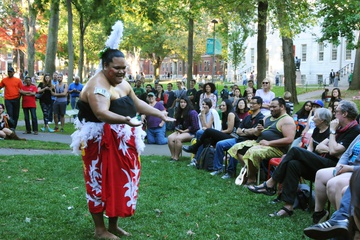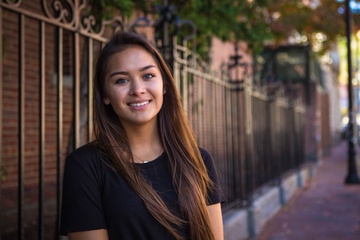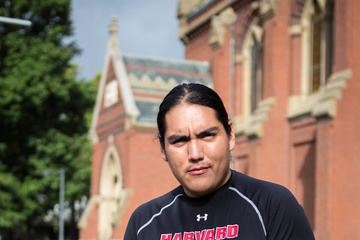“Close your eyes. What’s your first memory of food?”
Indigenous chef and activist Neftalí Durán poses this question to the 160 attendees of the Ivy Native Council Fall Summit, gathered in Boylston Hall. At the summit, Native American students from Ivy League colleges convene over issues facing indigenous people today. This fall, the issue on the table is “Indigenous Food in the 21st Century.”
The crowd is quiet until one student near the front speaks: “I remember smoking fish, and you can smell the smoke coming out of the smokehouse. It’s always the little ones who put enough salt in the water to make the potato float.”
Food might seem like an unusually specific topic to focus on, and it is. Past summits have mainly tackled wider questions of sovereignty. But Native Americans at Harvard College, the group that organized the Summit, has found that food impacts the lives of indigenous people in broader, weightier ways than most people are aware of.
“Everybody knows that indigenous people have been tormented for 400 plus years, and I think that food sovereignty and similar issues are other ways that indigenous people are still being oppressed,” says Noah D. Cominsky ’20, who is Ojibwe, from the Fond du Lac Band of Lake Superior Chippewa, and the social chair of NAHC. “People don’t necessarily realize that yeah, there’s the Dakota Access Pipeline, but there’s [also] this issue that people don’t really know about.”
As one speaker would later address, the issue of food access is deeply tied to high-profile water and energy conflicts like the one that sparked the 2016 protests at Standing Rock.
“Food has been used as a weapon against indigenous people for a very long time,” says Elizabeth M. Hoover, an assistant professor of American Studies at Brown University descended from Micmac and Mohawk communities in Upstate New York and Eastern Canada.
Energy disputes often threaten food supplies on Native land. One Minnesota pipeline was diverted from the south of the state “because that’s where all the people live,” says Hoover. Instead, the pipeline was planned to be constructed in the north, across tribal lands containing rice crops.
“It’s: ‘Here there be dragons and Indians,’” Hoover says. “What happens if and when these pipelines leak into these very sensitive wild rice beds?”
A few years ago, Hoover embarked on a 20,000 mile drive around the country, documenting 40 indigenous food projects. The project aimed to promote access to sufficient, healthy, sustainable food by reclaiming traditional diets.
Traditional diets tend to be healthy and plant-based, which could be a step to address the diabetes epidemic facing Native Americans. Eating traditional foods is also a way to sustain elements of language and culture that might otherwise be erased.
But the barriers to transforming Native diets are many. Eating historically can be expensive, and heritage plants can be nearly impossible to recover in non-native environments.
“There’s a history of resiliency of indigenous people in the kitchen,” says Duran, who teaches indigenous culinary tradition. “If you know how to make a tortilla, if you know how to grow anything, if you know how to smoke your fish, that’s… a remnant of survival against all odds.”
An oft-repeated question at the Summit: “What about the frybread?” Some Native chefs refuse to serve frybread because it was originally made using commodity ingredients imposed onto displaced Apache and Navajo people. Others embrace it, viewing it as a symbol of resourcefulness. Besides, it has become a staple of tribal cuisines—for many, it is a reminder of home.
And the Summit more broadly attempts to create a sense of home: Establishing community is central to its purpose. Many attendees either grew up in the same tribal communities or met during Ivy League pre-college recruitment trips. Each Ivy Native Council event is an opportunity to reunite.
Ashley N. Hamilton ’20, vice president of NAHC, is enrolled in the Winnebago tribe of Nebraska, though her mom is from the Kickapoo tribe in Kansas. She says one of her goals is to “Help [students] go through the difficulties of being a Native student at an institution that wasn’t made for them.”
“Harvard has a spot for us,” Cominsky says. “And we will always be working for that spot. We call Harvard home. We call each other home. And so we just want to be home.”





